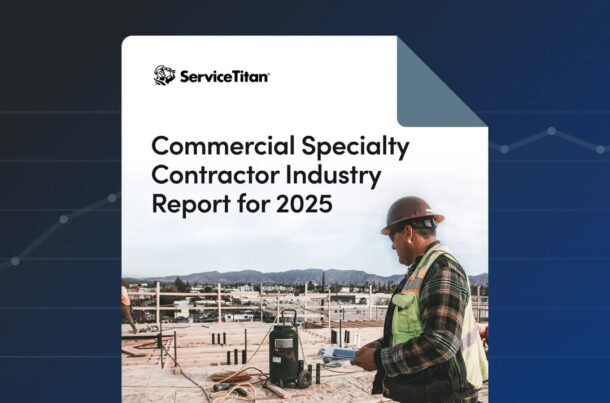Top Business Risks to Meeting Goals Include Rising Labor and Overhead Costs (63%), Increasing Material Prices (51%), and the Shortage of Skilled Labor or Workforce Availability (40%) ServiceTitan (Nasdaq: TTAN), a software platform built to power the trades, today released its Commercial Specialty Contractor Industry Report, a study of over 1,000 specialty contractors primarily in plumbing, HVAC Read more
Labor shortage

Top Business Risks to Meeting Goals Include Rising Labor and Overhead Costs (63%), Increasing Material Prices (51%), and the Shortage of Skilled Labor or Workforce Availability (40%)
ServiceTitan (Nasdaq: TTAN), a software platform built to power the trades, today released its Commercial Specialty Contractor Industry Report, a study of over 1,000 specialty contractors primarily in plumbing, HVAC, and electrical, that focus a significant part of their business on construction. The report reveals that amid significant hurdles, contractors are pushing for growth, with 93% focused on winning new projects. Of the factors threatening growth, nearly two-thirds (64%) anticipate material prices to increase, making it harder to forecast job costs and protect margins. The report also found that to stay agile, contractors are focused on diversifying service offerings (43%), improving project execution (59%), and internal processes (51%), which is spurring software adoption.
“The commercial sector is in the midst of a perfect storm with a fluctuating economy, regulatory changes, and rising costs,” said Alex Kablanian, Vice President and General Manager, Commercial & Construction Markets. “In this challenging landscape, adopting innovative technology, including artificial intelligence, is essential for streamlining operations and driving profitable growth even in uncertain times. Historically, we’ve seen the best operators use periods like this as a catalyst to harden their business and build long-term durability and it’s our job to help our customers make that happen.”

Increasing profitability with better cash flow management
Specialty contractors are optimizing operations to grow revenue, but in parallel with rising material prices, rising labor, and overhead costs are top challenges that could impact revenue growth this year. Only 50% of contractors factor volatile material costs into their planning, and as a result, 36% are regularly adjusting budgets mid-project to deal with unexpected material costs. Approximately 83% of contractors cite budget overruns as a top issue, as well as unplanned risks not covered by contingency funds or change orders (70%). To keep projects on track and financially stable, 57% of contractors are prioritizing cash flow management. In addition, to stay profitable contractors are aiming to secure better material pricing, including using general contractors’ preferred suppliers for discounts (65%) and building stronger supplier relationships for better pricing (40%). To drive profits, contractors must be strategic about the projects they take on with the report revealing a strong focus on optimizing bidding strategy (51%) and three-quarters (75%) of contractors are increasing their client base. A majority of respondents (70%) are converting less than 20% of their bids, with the average bid conversion rate at 17.9%. Bid conversion rates have remained the same year-over-year for 79% of respondents.
Impacts of the labor shortage on business volume and retention strategies
The ongoing labor shortage continues to impact the commercial construction sector, forcing specialty contractors to re-strategize areas for business growth. Forty percent of respondents indicate labor shortages as a primary risk to meeting goals and over three-quarters (76%) report they are actively hiring. Among the contractors who are decreasing bid volume, 46% say it’s because of workforce and capacity limitations.
While 63% of contractors cite labor costs as a top risk to meeting goals, as businesses are met with slim talent pools, over half (55%) still plan to raise wages. To recruit and retain top talent, contractors must offer competitive pay and factor employee wage increases into their budget.
Optimizing workflows to drive larger profits
Amidst a competitive talent war and heightened cost pressures, contractors must readily adopt technology to remain agile to alleviate cash flow. Approximately 63% of respondents indicate enhancing budget forecasting and accuracy as a top priority for improving cost management, followed by managing change orders and variances (62%) and streamlining cost tracking and reporting (54%). Only 46% of contractors think they have the necessary tools to effectively manage costs. Timely payments are also critical to driving revenue growth. Nearly 80% of respondents indicated timely billing as a top strategy for being profitable, with the majority of contractors noting 38 days as the average length of time for payment.
Technology investments for more efficient operations
To optimize workflows and drive efficiency, 80% of contractors use communication tools, 51% use project management software, and 40% use specialized workforce management software. Almost half (49%) continue to use spreadsheets, highlighting the potential for wider technology adoption. Thirty percent of contractors are looking to invest in technology to achieve their goals, with 59% hoping to improve project execution and 51% their internal procedures. AI adoption is growing with 17% already seeing it impact their business. Contractors believe document management (57%), reporting (41%), project planning and scheduling (20%), bid management (19%), and equipment and fleet management (17%) will be the most significant way AI transforms their businesses.
“ServiceTitan’s end-to-end platform fuels the growth of billion-dollar businesses, empowering commercial construction companies with enterprise-level capabilities to scale to their full potential,” said Kris Blankenship, Industry Advisor at ServiceTitan for Commercial and Construction. “AI adoption will be critical as these businesses look to increase efficiency and raise their bottom line.”
To review the full findings and key takeaways, download the Commercial Specialty Contractor Industry Report here.
One of the most noteworthy impacts of the COVID-19 pandemic has been the national labor shortage and the widespread media attention it has earned. According to Newsweek, there were 10.4 million job openings in the United States in September, but fewer than 8 million unemployed workers. That gap has placed enormous stress on the overall Read more
One of the most noteworthy impacts of the COVID-19 pandemic has been the national labor shortage and the widespread media attention it has earned.
According to Newsweek, there were 10.4 million job openings in the United States in September, but fewer than 8 million unemployed workers. That gap has placed enormous stress on the overall economy, from manufacturing and distribution to the retail and service sectors, as suppliers struggle to meet consumer demand.
For those in the skilled trades industries, this story is familiar. They have faced a chronic version of the overall labor shortage for decades.

Demographic challenges and misconceptions
The average age of skilled workers is now 43, according to one estimate from Angi. With fewer young people entering the trades every year, the situation is expected to get worse. The approaching wave of baby boomer retirements will only add to the problem.
For manufacturing, construction, and field service companies, the skilled trades crisis poses major ongoing challenges. It’s hard to maintain productivity and customer service while you’re understaffed or experiencing frequent turnover. Projects are often delayed because workers aren’t available. Revenue is lost for multiple reasons: worker inexperience, inefficiency, long work hours, or jobs that have to be postponed or turned down.
Unfortunately, many high school students and recent graduates who might thrive in the trades never consider a career in those industries. The message that college is the only path to success has become ingrained in our culture in the last 30 years. Despite the rising cost of higher education and the increasing number of students who never earn a degree, the college journey has eclipsed all other options.
In addition to highlighting the labor crisis, recent circumstances have demonstrated that manufacturing, distribution, and residential and commercial service jobs are a critical part of the national economy. These industries played a key role in public health and safety during lockdowns and periods of social distancing and quarantines. Many products and services provided by the HVAC and PHCC industries proved to be essential during the pandemic and have remained critical economic drivers as communities have reopened.
This national spotlight on the essential nature of the trades offers an opportunity to reorient public perception and correct the misconceptions that have contributed to the skilled trades labor gap.

Closing the gap
In response to the growing labor gap, trade organizations have partnered in recent years with vocational schools, employers, manufacturers, and public agencies to promote the trades as a viable alternative to a four-year degree. Their combined efforts are focused on the many immediate advantages offered by a skilled trades career:
- High wages
- On the job or employer-funded training
- Lack of student debt
- Immediate available positions
- A wide variety of vocational options and career trajectories
- Entrepreneurial opportunities
Additionally, advocates and thought leaders are making the case for other long-term strategies that will create a more effective and reliable talent pipeline. Among those ideas is diversification. Many communities have traditionally been underrepresented in the trades; focusing recruitment, outreach, and marketing efforts in those communities can build trust and allow the trades industries to connect with vibrant new pools of talent.

Immediate solutions
Those efforts, however, will take time to pay off. In the meantime, employers are still faced with a labor crisis of historic proportions and the urgent need to operate efficiently in order to remain competitive in this challenging economic climate.
In order to maintain productivity throughout the remainder of the pandemic and during recovery, many employers are looking for immediate solutions. While there is no magic bullet that will compensate for a labor shortage, there are a number of new and emerging tools available that can help companies boost efficiency and productivity so they can continue to deliver results for their customers.
The pandemic has focused a spotlight on the importance of the technology revolution that was already underway among skilled service providers. Some of the major technology trends and developments that have been accelerated by the pandemic and its fallout are:
- Mobile and remote capabilities: As COVID-19 forced many employees across multiple industries to work cohesively without a physical office, technician mobile apps and other remote technologies have become invaluable to commercial contractors of all types. Today, various mobile applications give teams remote work capabilities that weren’t possible a decade ago.
- Modular construction: The modular construction market is seeing an increase in business, which is in response to combined cost-effective construction technology and labor shortages. Modular and offsite construction continues to grow and contribute to less expensive housing and commercial construction. In addition to their convenience, other benefits of modular projects include the ability to more effectively regulate worker safety within ventilated and climate-controlled workspaces. These advantages also further help workers comply with social distancing guidelines.
- Artificial Intelligence: Artificial intelligence (AI) is capable of lowering the cost of construction and service while helping teams successfully plan and schedule projects. AI is frequently used in software to conduct analyses and simulations in a variety of hypothetical situations and environments. In turn, AI is invaluable in developing new safety protocols and minimizing the risk of workplace injuries. Its role is expected to continue to rise in response to the workforce shortage exacerbated by COVID-19 shutdowns.
- Integrated software solutions: The number of contractors who still rely on pencil and paper or spreadsheets for record-keeping and accounting has steadily dwindled over the last decade, and sharply declined during 2020. Simply switching from manual job management to an enterprise solution can generate major gains for most businesses. A single all-in-one platform is critical for efficiency; requiring technicians to move back and forth between multiple apps not only takes up precious work time, it can serve as an obstacle to adoption.
- When actionable data from across departments is collected and accessible in real time, all parties involved in a project benefit. Up-to-the-minute insights and transparent communication empower purposeful, immediate decision-making and fast, accurate execution.
Resolving the labor shortage that has challenged the skilled trades will be a win not only for the industries involved. The long-term strategies currently being deployed will expand the choices available for young people and dismantle the preconceived notion that a college degree is required for success. By opening up opportunities for vocational training and apprenticeships in place of a university program, we can ensure young people are on the right track from the start. Presenting the trades as a viable option could also help reduce the national burden of student debt and alleviate college dropout rates.
In order to find and implement a comprehensive solution, it is imperative that we examine and assess our educational pipeline and deliver an authentic message about the advantages and opportunities of skilled trades careers. Innovation is the key to ensuring America’s workforce is prepared and supported.
For more information on this subject, visit www.buildops.com.
